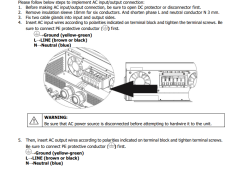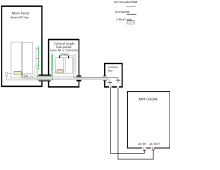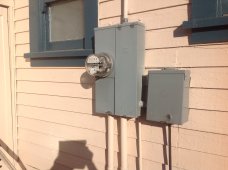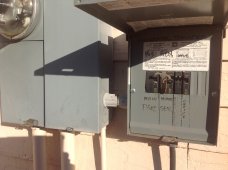sethile
New Member
- Joined
- Dec 29, 2021
- Messages
- 113
This is an off grid installation using a single MPP LV6548. I'm working on a critical loads panel, and trying to plan the AC wiring while waiting for my LV6548.
Two pressing questions I'm trying to research have me confused. In case it is relevant here is a (link to previous thread) discussing the PV side and includes a block diagram and discussion of the set up.
Main AC side questions:
1. Is it OK to have the grounds and neutrals all bonded between the Main panel, Critical Loads panel, and the LV6548 AC input and output? That seems dicey to me, but it looks like what will happen if I follow what seem to be credible instructions. If so, is there any danger of feedback into the grid when the grid goes down?
Here's the set up as I understand it:
The grounds and neutrals look to be bonded in my main panel.
The instructions I've seen for the critical loads sub panel seem to indicate I should:
2. Wire runs:
My confused understanding is I can run NM-B (stranded Romex style cable) in the wall, but can't run it all the way to the LV6548 as that would have it exposed. And I can have SOOW run from the wall to the LV6548, but not in the wall. Is that correct?
If so, the best plan I've come up with is to run 6/3 NM-B from the main panel (50A breaker), through the bottom of the critical loads panel, out the other side, through the wall studs to the wall of the closet where the LV6548 will live. Then connect that to 6/3 SOOW in a junction box, which I can then run out of the wall to the LV6548 AC in.
The LV6548 AC out is connected with 6/3 SOOW back to the junction box, where it connects to 6/3 NM-B, which then runs through the wall and connects to the critical loads panel.
By way of a picture is worth a thousand words (not sure it's going to help much):
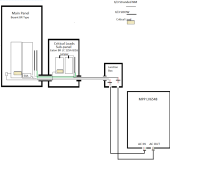
And in case they help, photos of the Main panel, critical load panel, and the massive hole I made in the wall of the closet in order to drill through the studs:
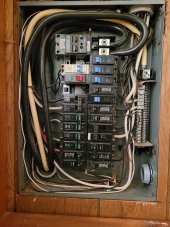
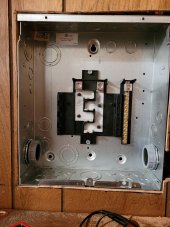
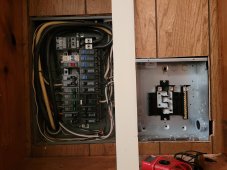
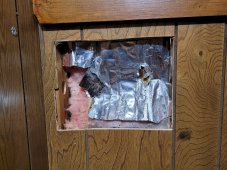
Thanks for getting this far! Any thoughts?
Two pressing questions I'm trying to research have me confused. In case it is relevant here is a (link to previous thread) discussing the PV side and includes a block diagram and discussion of the set up.
Main AC side questions:
1. Is it OK to have the grounds and neutrals all bonded between the Main panel, Critical Loads panel, and the LV6548 AC input and output? That seems dicey to me, but it looks like what will happen if I follow what seem to be credible instructions. If so, is there any danger of feedback into the grid when the grid goes down?
Here's the set up as I understand it:
The grounds and neutrals look to be bonded in my main panel.
The instructions I've seen for the critical loads sub panel seem to indicate I should:
- run THHN between the ground and neutral buses on main panel to the ground and neutral buses of critical load panel. Note: The critical loads panel only has a neutral buss, no ground buss, but if they are already combined in the main, it seems redundant to add a separate ground buss. Maybe this would solve what I'm concerned and confused about, but I don't see how it would since they are combined in the main panel.
- then for each circuit I want to move I would remove the wire from the circuit breaker main panel, splice THHN to the wire
- run the spliced wire to the critical loads panel, and reconnect the breaker there.
2. Wire runs:
- I have the main and critical load panels flush mounted on either side of a stud in the back wall of a cabinet, with a nipple between them.
- My LV6548, battery, and fused solar disconnect will be in an adjacent closest.
- I have a nipple going out the other side of critical loads panel (away from the main panel, and toward the closet), and have prepared the studs for a wire run through them in the wall to the wall of the closet.
My confused understanding is I can run NM-B (stranded Romex style cable) in the wall, but can't run it all the way to the LV6548 as that would have it exposed. And I can have SOOW run from the wall to the LV6548, but not in the wall. Is that correct?
If so, the best plan I've come up with is to run 6/3 NM-B from the main panel (50A breaker), through the bottom of the critical loads panel, out the other side, through the wall studs to the wall of the closet where the LV6548 will live. Then connect that to 6/3 SOOW in a junction box, which I can then run out of the wall to the LV6548 AC in.
The LV6548 AC out is connected with 6/3 SOOW back to the junction box, where it connects to 6/3 NM-B, which then runs through the wall and connects to the critical loads panel.
By way of a picture is worth a thousand words (not sure it's going to help much):

And in case they help, photos of the Main panel, critical load panel, and the massive hole I made in the wall of the closet in order to drill through the studs:




Thanks for getting this far! Any thoughts?
Last edited:



